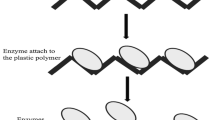Abstract
Size selective feeding by Brachionus plicatilis was investigated with algae and bacteria (0.3–3.5 µm) and mono-disperse latex beads (0.3–3.0 µm) in short term feeding experiments.
B. plicatilis demonstrated maximum clearance rate of particles with diameter ≥2µm, but particles with diameter down to 0.3 µm were also ingested. The clearance rate of bacteria was 15–55% of that obtained for optimal sized particles (≥2 µm), and was related to particle size. The relative reduction in retention of particles with diameter < 2 µm was more pronounced for latex beads than for natural food particles, suggesting other mechanisms than size to be important for the particle retention by the rotifer. This is emphasized by the fact that the clearance rates were much lower for latex beads than for natural food particles of comparable size. Efficient retention of bacteria was observed for rotifers in poor physiological condition, i.e. rotifers with low maximum clearance rate. This may reflect a strategy to optimize energy utilization by reducing locomotion costs and increasing energy intake.
The results indicate that B. plicatilis has a low to medium ability to feed on bacteria. In natural ecosystems, its importance as a bacterial grazer is of limited importance. At high population densities, such as in live feed cultures, the rotifer may, however, efficiently remove bacteria from the culture.
Similar content being viewed by others
References
Azam, F., T. Fenchel, J. G. Gray. L. A. Meyer-Reil & F. Thingstad, 1983. The ecological role of water-column microbes in the sea. Mar. Ecol. Prog. Ser. 10: 257–263.
Bern, L., 1990. Size-related discrimination of nutritive and inert particles by freshwater zooplankton. J. Plankton. Res. 12: 1059–1067.
Brendelberger, H. & W. Geller, 1985. Variability of filter structures in eight Daphnia species: mesh sizes and filtering area. J. Plankton Res. 7: 473–486.
Bogdan, K. G. & J. J. Gilbert, 1987. Quantitative comparison of food niches in some freshwater zooplankton. Oecologia (Berl.) 72: 331–340.
Børsheim, K. Y. & Y. Olsen, 1984. Grazing activities by Daphnia pulex on natural populations of bacteria and algae. Verh. int. Ver. Limnol. 22: 644–648.
Cole, J. J., S. Findlay & M. L. Pace, 1988. Bacterial production in fresh and saltwater ecosystems: a cross-system overview. Mar. Ecol. Prog. Ser. 43: 1–10.
DeMott, W. R. 1986. The role of taste in food selection by freshwater zooplankton. Oecologia (Berl.) 69: 334–340.
Dewey, J. M. 1976. Rates of feeding, respiration and growth of the rotifer Brachionus plicatilis and the dinoflagellate Noctiluca miliaris in the laboratory. Ph. D. Thesis Univ. Wash. 117 pp.
Epp, R. W. & W. M. Lewis, 1984. Cost and speed of locomotion for rotifers. Oecologia (Berl.) 61: 289–292.
Hobbie, J. E., J. R. Daley & S. Jasper, 1977. Use of nuclepore filters for counting bacteria by fluorescence microscopy. Appl. Envir. Microbiol. 33: 1225–1228.
Korstad, J., O. Vadstein & Y. Olsen, 1989. Feeding kinetics of Brachionus plicatilis fed Isochrysis galbana. In C. Ricci, T. W. Snell & C. E. King (eds), Rotifer Symposium V. Developments in Hydrobiology 52. Kluwer Academic Publishers, Dordrecht: 51–57. Reprinted from Hydrobiologia 186/187.
Lubzens, E., A. Tandler & G. Minkoff, 1989. Rotifers as food in aquaculture. In C. Ricci, T. W. Snell & C. E. King (eds), Rotifer Symposium V. Developments in Hydrobiology 52. Kluwer Academic Publishers, Dordrecht: 387–400. Reprinted from Hydrobiologia 186/187.
Perez Benavente, G. & F. J. Gatesoupe, 1988. Bacteria associated with cultured rotifers and artemia are detrimental to larval turbot, Scophthalmus maximus L. Aquacultural Engineering 7: 289–293.
Rothhoupt, K. O. 1990. Differences in particle-size-dependent feeding efficiencies of closely related rotifer species. Limnol. Oceanogr. 35: 16–23.
Skjermo, J. & O. Vadstein, 1993. Characterization of the bacterial flora of mass cultivated Brachionus plicatilis. Hydrobiologia 255/256: 185–191.
Author information
Authors and Affiliations
Rights and permissions
About this article
Cite this article
Vadstein, O., Øie, G. & Olsen, Y. Particle size dependent feeding by the rotifer Brachionus plicatilis . Hydrobiologia 255, 261–267 (1993). https://doi.org/10.1007/BF00025847
Issue Date:
DOI: https://doi.org/10.1007/BF00025847




